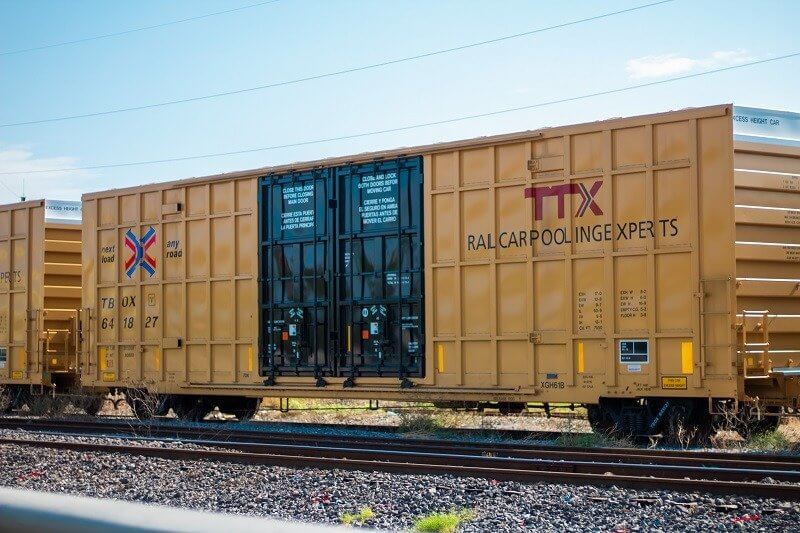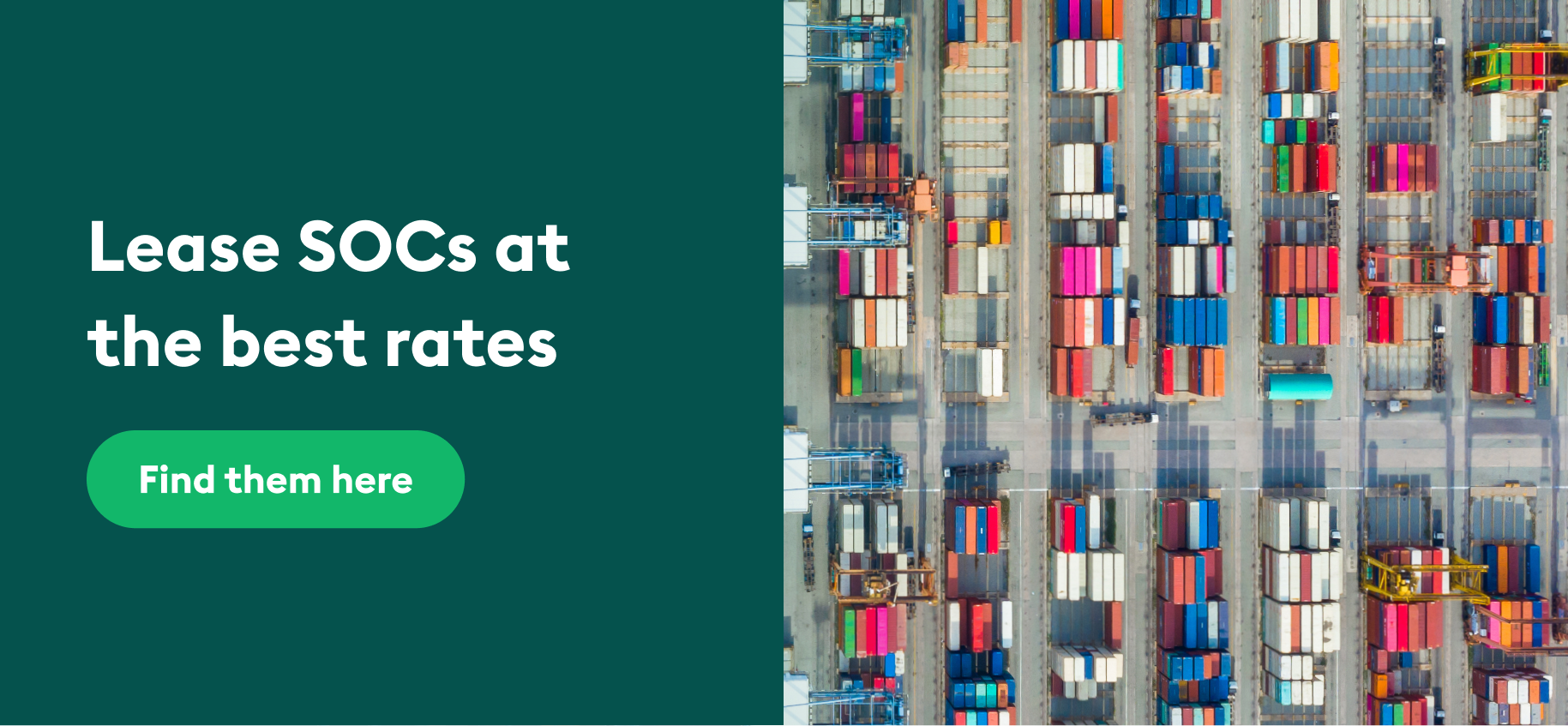Considering using rail freight to ship your cargo? In this blog, you’ll get the complete picture of the rail freight market, plus advantages and challenges in the industry. What’s more, find out how you can get your hands on SOC containers at the best rates, along your desired routes on Container xChange.
Rail freight is fast, reliable, and much more environmentally friendly than ocean or air freight. And it’s growing steadily. Rail connections between China and Europe increased from just 5,000 trains in 2018 to 15,000 trains in 2021.
However, this transport method is not without its setbacks. Routes are still quite limited, and with an increase in rail traffic in the past few years, making sure you have enough containers at all times can be tricky. Plus, there’s the added stress of repositioning your equipment empty.
If you struggle to find containers to lease when you need them most, don’t give up just yet. On Container xChange, we’ve got all types of SOCs available at completely negotiable rates.
On our platform, you can lease containers for one-way moves and avoid empty container repositioning altogether. With over 50,000 containers available in 2,500+ locations around the world, you’re bound to find what you’re looking for. To add to this, all of our suppliers are vetted, and payments on the platform are 100% safe and secure.
How about you give it a go yourself to see just how easy it is to find the equipment you need? Simply type in your requirements and hit ‘search’, to browse available containers right now.
How does rail freight work?
Rail freight transportation involves the use of railroads and trains to transport cargo via land. It can be used for entire journeys, or to transport goods part of the way along a route where ocean or road freight isn’t possible.
Rail is used to transport the following:
- Agricultural goods
- Vehicles
- Chemicals
- Raw building materials
- Coal, oil and wind turbines
- Wood logs
Freight trains can haul bulk cargo, standardized shipping containers, or rail cars/goods wagons designed for a particular type of freight. Let’s learn more about the containerization of rail freight in the next section.
Containerization of rail freight
The majority of the cargo transported by rail is still handled as bulk cargo – goods transported unpackaged, in large quantities.
But since the introduction of standardized container sizes, rail freight is using containers more than ever. Why? Because cargo from various shippers can be placed into one container, saving time on loading and unloading.
Now let’s look at how containers are used in rail freight transportation:
Standard containers: Thanks to ISO regulations, 20ft and 40ft dry containers must always have the exact same dimensions, no matter where they are in the world. This has simplified the transportation of shipping containers over varied gauge sizes to a great extent.
Incompatible gauge sizes (the distance between the two rails of a track) used to make transshipment between countries difficult. But now, shipping containers can be loaded and unloaded from rail flatcars without being opened, making transshipment faster and more efficient.
Double-stack containers: To put it simply, double-stack containerization means putting two shipping containers on top of each other. This way, special railroad cars – called well cars – can carry almost twice as much cargo.
This is how it looks:
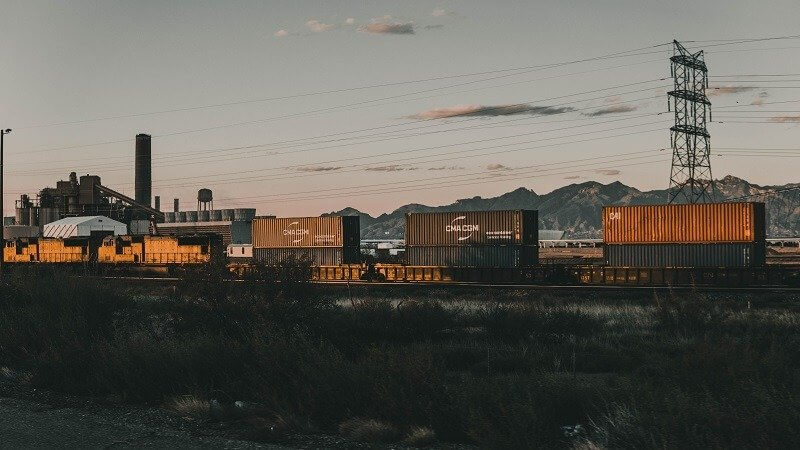 Piggy-back: As we all know, railroads always end at some point. Plus, there are railways to destinations that trucks can’t reach. To tackle these issues, a form of combined transportation – the rolling highway – or ‘piggy-back’ service exists.
Piggy-back: As we all know, railroads always end at some point. Plus, there are railways to destinations that trucks can’t reach. To tackle these issues, a form of combined transportation – the rolling highway – or ‘piggy-back’ service exists.
This means that trucks can drive onto a railroad flatcar and drive off when the train reaches the endpoint.
Now that we have seen how containers are used in rail freight transportation, let’s look at what kind of containers are used by forwarders. You’ll be surprised to know that unlike ocean freight, rail freight forwarders actually prefer shipper-owned containers (SOCs) over carrier-owned containers (COCs).
Why does the rail freight industry use SOC containers?
As with shipping, you might consider using COCs (owned by rail freight forwarders) when moving your cargo via rail. While this may seem more convenient, it comes with its challenges:
Lack of supply
With rail COCs, the supply of containers may be limited, especially at times of rising demand. Since the Covid-19 pandemic, rail traffic has increased significantly, meaning that containers are booked up quickly.
In scenarios like this, getting containers can be tricky. Not finding containers when you need them can seriously slow down your operations, wasting both time and money, not to mention frustrating your customers.
As a result, forwarders use SOCs to maintain an ample supply of containers for their clients. With SOCs, you can find containers at any time. At last, access equipment along your particular route, even at short notice.
Avoiding empty container repositioning
Do you often have containers you need to reposition empty after a rail journey? That’s a huge waste of time, money and fuel.
What if we tell you that you can free yourself of the burden of repositioning by leasing SOCs instead? This is the perfect time to lease containers on Container xChange. Simply move cargo to the required destination and then forget about the equipment altogether – it’s no longer your problem! No more stressing about storage costs or trying to find a shipper to fill your container.
Limited routes = limited flexibility
With COCs, routes can be limited, posing issues for your business. Limited flexibility can seriously hinder your operational flow, and leave your customers unhappy. With SOCs, send containers along the exact routes you need, plus decide for yourself how to get them to and from the rail line.
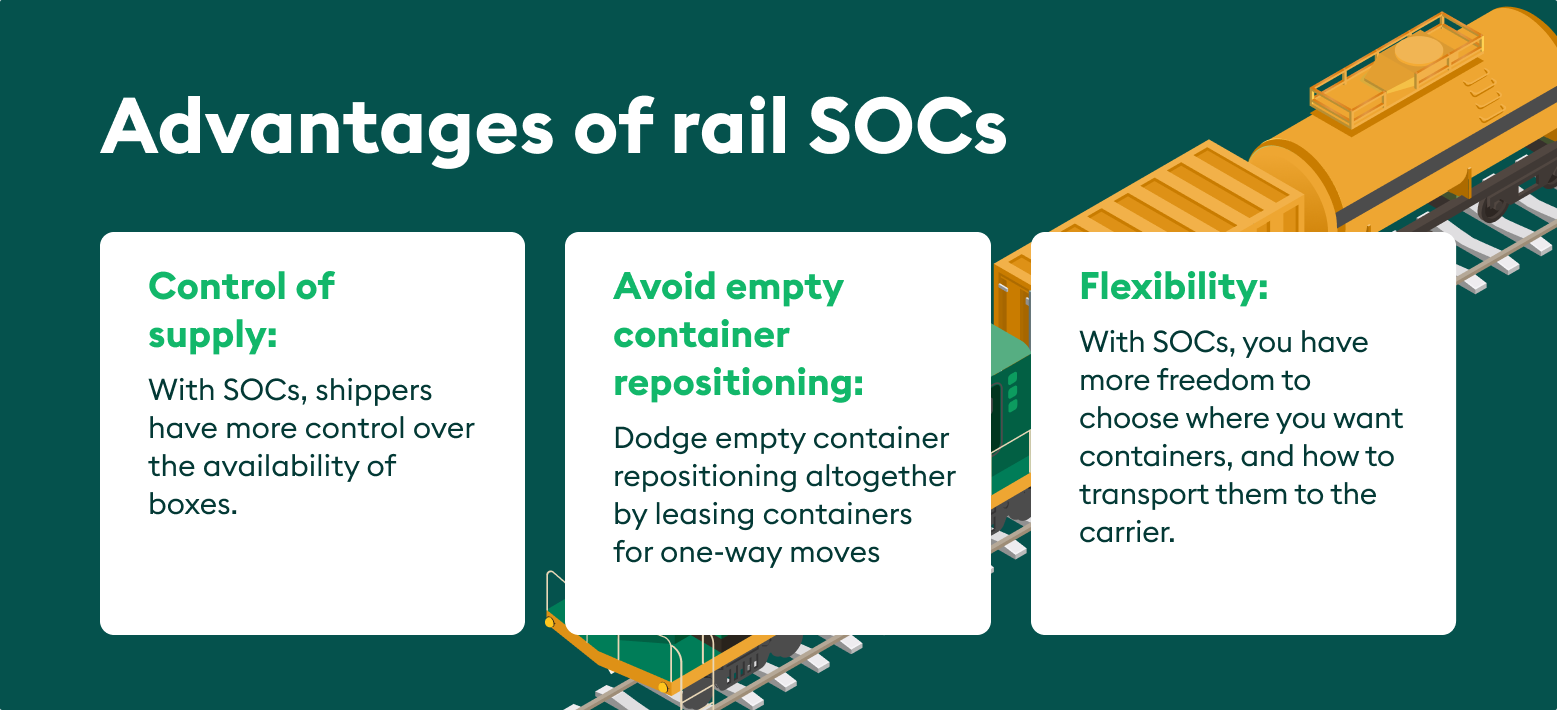
Want to learn more about SOCs? Click here for a full guide.
How to source SOCs for your rail freight operations
So now that you know why SOCs are beneficial, it’s time to learn how you can source them for yourself. On Container xChange, we’ve got SOCs of all container types and sizes, available in over 2,500 locations around the globe.
Once you’ve joined our platform, head on over to our leasing search, type in your requirements, and browse available offers. You’ll be able to compare the rates of various deals so that you can make the best decision for your budget.
Not happy with the rates, terms, or conditions of the deal? No problem – hop onto a chat with the supplier to negotiate. Yes, you read that right, no middlemen involved. What’s more, the rate you decide on is the rate you’ll pay. We won’t surprise you with any hidden costs or added commissions later on.
Once you’ve signed the deal, all payments will be dealt with using the xChange wallet. Keep track of all transactions and make completely safe and secure payments, directly on the platform.
Sounds good, right? So why not start the process today? In no time, you’ll be sourcing SOCs along the routes you need, at rates you’re comfortable with. Click below to begin your journey with us today.
Rail freight: Overview of the market
The rail freight transport market was valued at $247.39 billion in 2020, and is expected to register a CAGR (compound annual growth rate) of about 2% from 2021 to 2026.
In the US alone, the rail freight transportation market was estimated at $58 billion in 2022. And the country currently accounts for 34.4% of the global market share. China, as the world’s second-largest economy, is predicted to reach an estimated market size of $35.4 billion in the year 2026.
Japan and Canada are other noteworthy players in the rail freight market with a forecast to grow 2.8% and 4.1% respectively, between 2021 and 2026. Germany is predicted to grow at approximately 3.3% CAGR, while the rest of the European market will reach $35.5 billion by the end of 2026.
The impact of Covid-19 on the rail freight industry, in general, has been mixed. While the US and South America saw a general decline in the market, Asia and Europe experienced a significant rise in traffic.
Due to the recent war in Ukraine, we also saw large players in the shipping industry, including Maersk, MSC, and CMA CGM, halting all dealings with Russia. This increased the pressure on the rail industry, as shippers scrambled for alternative routes to move their cargo.
Overall, the rail industry can expect to see:
- Bigger investments in the rail network as a whole
- Major infrastructure development, including improving and repairing rails and expanding routes
- The adoption of more digital technology to streamline and simplify processes
Heard of the Belt and Road initiative? We’ll cover this in the next section.
New Silk Road: Freight rail network connecting Asia to Europe
The Belt and Road initiative is a project aimed at connecting China with the rest of the world. This includes developing rail routes between China and South East Asia, Europe and Africa.
Since President Xi Jinping announced the plan in 2013, China has sent more than 11,000 freight trains to Europe and back. In 2018, more than 6000 trains made the journey from China to Europe, a 72% increase compared to 2017.
The project initially aimed to deepen the cooperation between the Chinese and the European markets. So far, it has been reported as successful. Especially during the pandemic, when shipping ports became congested and alternative transport modes were needed.
As of December 2019, 152 countries were actively involved in the Belt and Road Initiative. China has also been heavily investing in Asian and European industries, including banking, automobile, robotics, power utility, solar farms, and ports.
Experts estimate that China will spend up to 8 trillion dollars as part of this initiative until 2049, which is the targeted year of completion. Learn more about the Belt and Road project in this blog.
How much will rail freight transportation cost you?
Yes, rail freight transportation is more expensive than ocean freight. However, in places where transportation through harbors is not possible, rail is an efficient and safe alternative.
To estimate your rail freight rates, you have to take various factors into account. These include:
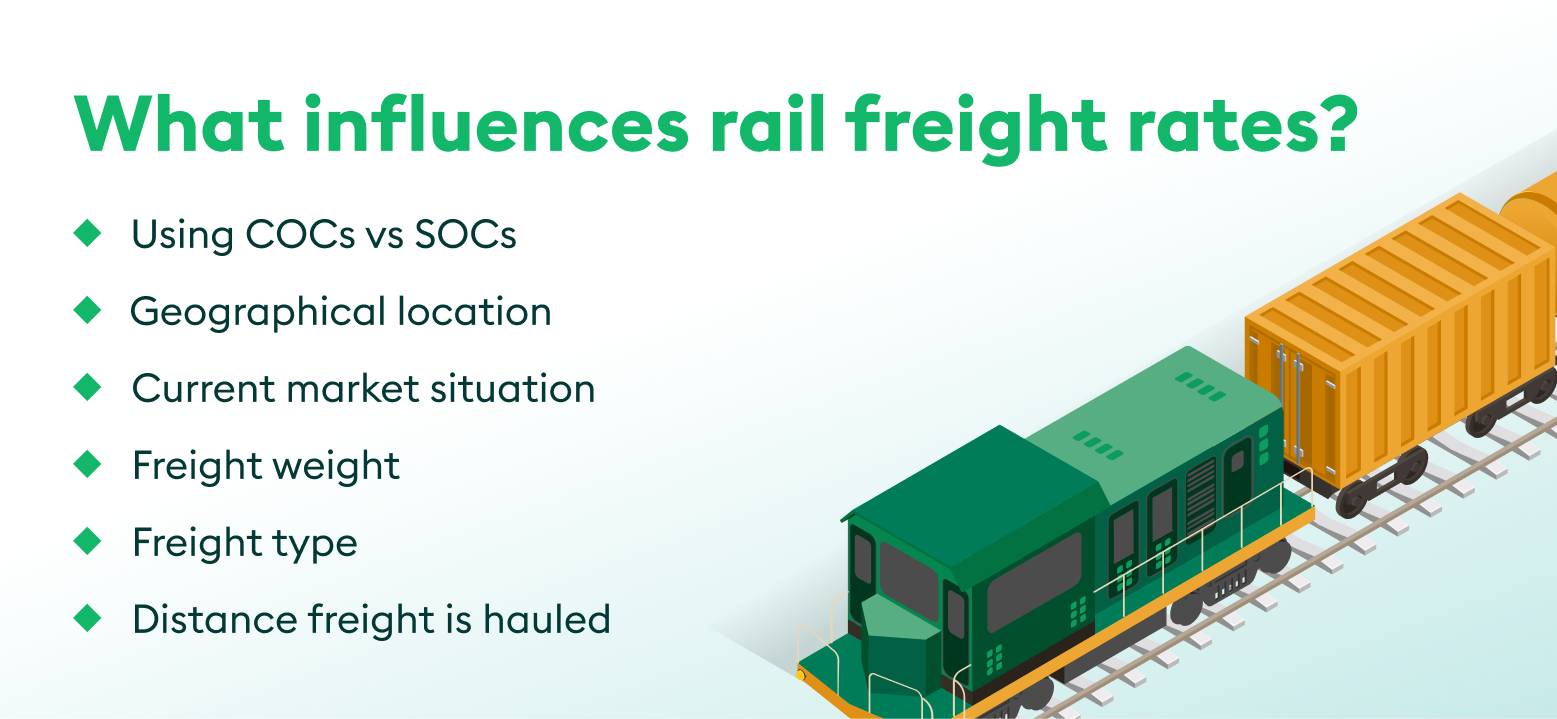
For a rail freight trip from China to Europe, you’re looking at between US $8000 – $9000 for a 40ft container.
In comparison, shipping a 20ft container via ocean freight from China to Northern Europe will cost you only US $1,500. So if time is on your side, ocean freight is a much more budget-friendly option.
That being said, rail freight does have some major advantages over shipping. Let’s check our some of the benefits below.
Benefits of rail freight
There are many reasons to choose rail freight to transport your goods. Here are a few of the main ones:
Fast and reliable:
Especially compared to ocean freight, rail freight is faster. One of the biggest challenges shippers face with ocean freight is long lead times. Take the journey from China to Europe for example. A ship takes between 6 and 7 weeks to travel between these two continents, whereas by rail, cargo can move between China and Europe in half that time.
With regards to road transport, rail freight again comes out on top, as it’s not susceptible to congestion, accidents or road works.
As rail freight is not affected by weather like ocean freight, and congestion like road freight, it’s also the most reliable transport method of them all.
Safe and efficient:
Rail freight is safer than ocean, air or road freight. Just think about it: Accidents on rail are few and far between, and it’s not affected by rough seas or storms. Also, as compared to trucking, rail routes are set. Whereas truck drivers can stop anywhere along a route, putting goods at risk during rest periods.
Lower environmental impact:
Ocean and air freight have a significant negative impact on the environment. Let’s take the distance between China and Northern Europe for example. Air freight emits 139 tons of CO2. The combination of sea and air emits about 77 tons of CO2.
On the other hand, rail freight emits only five tons of CO2. In comparison, it is a drop in the ocean, meaning that rail is by far the most eco-friendly option available.
Challenges in rail freight transport
That being said, rail freight is not without its obstacles. Here are a few of them:
More expensive than ocean freight:
If an important factor in choosing between ocean and rail is price, it might be better to opt for ocean freight. Shipping may take double the time, but it’s roughly half the price of rail transport.
Unsafe for fragile goods:
Rail freight isn’t ideal for transporting glass or other fragile cargo. This is because trains sometimes halt suddenly, or speed up very quickly.
Limited routes available:
Railroads are still limited, especially in rural areas around the world. This means that transshipment may be necessary.
Loading and unloading cargo onto different modes of transport can increase the possibility of delays, loss and theft, as well as being more costly. Depending on the route, shipping goods may be the better option in certain cases.
Get SOC containers at the best rates on Container xChange
Are you ready to get SOC containers at prices you’re comfortable with, along the routes you need? Plus, avoid those empty container repositioning woes for good? Then it’s time to sign up as a member on Container xChange.
Here are just a few of the benefits you’ll enjoy:
- 50,000+ containers available in over 2,500 locations
- Work with vetted and reliable partners
- Safe payment handling with the xChange wallet
- Negotiable prices and 0% commission on deals
- No middle-men: Deal directly with suppliers
If our leasing platform is exactly what you’re looking for, click below to sign up for your free demo with our expert team today. You’ll get a sneak peak of the platform, and learn all about how you can lease containers at the best price for your budget, and increase flexibility at the same time.
What does rail freight mean?
Rail freight is the transport of goods on trains via rail, as opposed to air, ocean or road transport. This includes bulk cargo in wagons/rail cars, and containerized transport.
What are the advantages of rail freight?
Rail freight is much faster than ocean freight, cutting journey times by up to half. It’s also much more environmentally friendly than air and ocean transport, releasing much lower levels of CO2.
How much freight is moved by rail?
In the US alone, freight railroads move around 1.7 billion tons across nearly 140,000-miles of track each year.



